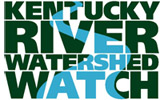Members of Headwaters participated in the Kentucky River Watershed Watch Pathogen Sampling Event on May 13th and 14th. Various samples were collected from streams throughout the North Fork watershed and taken to a local lab for E. coli testing.
E. coli samples are gathered as a measure of sewage contamination. Raw sewage has consistently been a major contaminant in Letcher County waterways. This sewage contamination stems from the prevalence of straight pipes and failing septic systems. Straight pipes empty untreated sewage waste directly from homes into waterways while failing, or, improper septic systems allow waste to migrate through the ground into waterways. Animals and livestock contribute to raw sewage contamination; however, straight pipes and failing septic systems have habitually been the main cause of this contamination. Raw sewage pollution and the presence of fecal coliform not only make stream water unsafe to come in contact with, but also puts stress and added costs on water treatment systems.
When collecting grab samples, the customary field data includes dissolved oxygen, pH, temperature, and conductivity. Dissolved oxygen is the amount of oxygen present in the water. It is necessary to aquatic life as many organic and inorganic reactions are controlled by dissolved oxygen. Mountain streams characteristically contain high levels of dissolved oxygen. This is the case as stream water is rapidly moving and typically maintains low temperatures. When dissolved oxygen drops below 5 mg/L there are negative consequences on the aquatic habitat. When levels drop to 1 or 2 mg/L, even for a short time, aquatic life is often killed.
pH is the measure of the acidity of water or the amount of free hydrogen and hydroxyl ions in the water. pH ranges from 0 to 14 with 7 being neutral, lesser measures being acidic, and greater measures being basic. For an idea of how significance of the scale, water with a pH of 5 is ten times more acidic than water with a pH of 6. The pH is an important measure as it determines the solubility and is an indicator of chemical change. For instance, heavy metals are more soluble or toxic at a lower pH. When it comes to surface water, the pH should be between 6.5 and 8.5.
Temperature is an important parameter when studying stream health. Aquatic organisms are completely dependent upon temperature and are often adapted to live within a very specific range. As temperature raises, chemical reactions generally increase and less oxygen is maintained in water. While temperature fluctuates daily and seasonally, cold water streams, like those of the headwaters, should not exceed 68 degrees Fahrenheit.
Conductivity is a measure of the availability of a solution to carry an electrical current. In other words, it is the water’s ability to conduct electricity. This provides a measure of the inorganic dissolved solid ions. The naturally occurring conductivity of headwater streams is about 100 to 200 microsiemens/cm. When conductivity rises to 300 micromhos/cm aquatic life becomes impacted and at 500 microsiemens/cm can no longer exist.
Members of Headwaters participate in KRWW sampling and collect field data various times throughout the year in order to raise awareness of local stream conditions and create a continuous record of water quality data. With public awareness of easily accessible water quality data, action can be taken to improve local waterways. Water quality is fundamental to the wellbeing of local communities; with improved water quality comes a bettered environment, restored recreation activities, and an enhanced setting for sustainable economic development.

